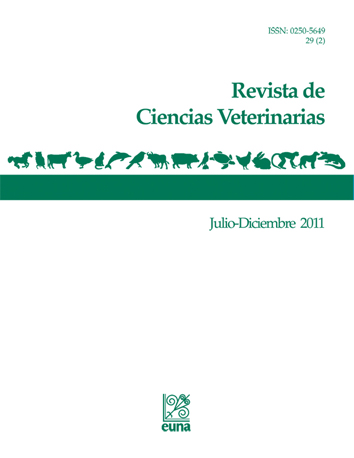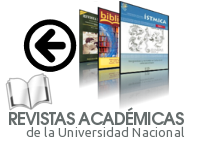Isolation and identification of pandemic influenza virus H1N1/2009 S-OIV from commercial and backyard swine in Costa Rica
Keywords:
Influenza Virus, PCR Real Time, H1N1/2009 S-OIV, swine, pigs, public health, Costa RicaAbstract
Influenza viruses are a threat not only to international trade of animal products but also to human health. The isolate H1N1/2009 S-OIV was diagnosed in mid-2009 in Mexico and the United States of America as a new variant of influenza in humans, and then was declared a pandemic by the World Health Organization (WHO). Costa Rica was the fourth country in the Americas to demonstrate the presence of this swine variant in humans. In 2010, the Food and Agriculture Organization of the United Nations (FAO) encouraged public awareness in some American countries like Costa Rica, where FAO sponsored and organized a program for detection and characterization of influenza H1N1 in pigs. To ascertain whether H1/N1/2009 S-OIV was present or not in Costa Rican swine herds, a distributed sampling of 509 pigs from 25 farms was conducted from across all of the Costa Rican provinces. The results confirmed the presence of this subtype in at least 2 of the sampled farms. In one case, nasal swabs from 11 pigs tested positive in Real-time PCR (RRT-PCR) and were confirmed using virus isolation. The second case was found positive by RRT-PCR but was not confirmed by virus isolation. Phylogenetic studies based on HA, NA and M genes showed that this variant is closely related to previously reported H1N1/2009-S-OIV worldwide sequences from human origin. This finding should be brought to the attention of local and global human and animal health agencies (e.g. WHO, OIE). This report also shows the usefulness of conducting surveillance on farms where poultry, wild birds, pigs and humans interact, in order to improve early detection and prevent the spread of possible new variants that can become pandemic strains.
References
Bi, Y., G. Fu, J. Chen, J. Peng, Y. Sun, J. Wang, J. Pu, Y. Zhang, H. Gao, G. Ma, F. Tian, I. H. Brown, J. Liu. 2010. Novel swine influenza virus reassortants in pigs, China. Emerging Infectious Diseases. 16 (7): 1162–1164. doi:10.3201/eid1607.091881
Chan, C. H., K. L. Lin, Y. Chan, Y. L. Wang, Y. T. Chi, H. L. Tu, H. K. Shieh, W. T. Liu. (2006). Amplification of the entire genome of influenza A virus H1N1 and H3N2 subtypes by reverse-transcription polymerase chain reaction. Journal of Virological Methods. 136 (1-2): 38–43. doi:10.1016/j.jviromet.2006.03.027
Di Trani, L., B. Bedini, I. Donatelli, L. Campitelli, B. Chiappini, M. A. De Marco, M. Delogu, C. Buonavoglia, G. Vaccari, G. 2006. A sensitive one-step real-time PCR for detection of avian influenza viruses using a MGB probe and an internal positive control. BMC Infectious Diseases. 6: 87. doi:10.1186/1471-2334-6-87
Dong, C., L. Ying, D. Yuan. 2011. Detecting transmission and reassortment events for influenza A viruses with genotype profile method. Virology Journal. 8: 395. doi:10.1186/1743-422X-8-395
Dotis, J. & E. Roilides. 2009. H1N1 influenza A infection. Hippokratia. 13 (3): 135–138. Retrieved from http://www.pubmedcentral.nih.gov/articlerender.fcgi?artid=2765289&tool=pmcentrez&rendertype=abstract
Ferrari, G., J. Pinto, N. Honhold, J. Zingeser, G. Dauphin, M. Kim, K. Dietze, J. Domenech and J. Lubroth (n.d.). FAO guidelines for surveillance of pandemic H1N1/2009 and other influenza viruses in swine populations (p. 19). Retrieved from http://www.fao.org/Ag/AGAInfo/programmes/en/empres/AH1N1/docs/h1n1_guidelines_fao.pdf
Fouchier, R. A. M., V. Munster, A. Wallensten, T. M. Bestebroer, S. Herfst, D. Smith, G. F. Rimmelzwaan, B. Olsen, A. D. M. E. Osterhaus. 2005. Characterization of a novel influenza A virus hemagglutinin subtype (H16) obtained from black-headed gulls. Journal of Virology. 79 (5): 2814–2822. doi:10.1128/JVI.79.5.2814-2822.2005
Garten, R. J., C. T. Davis, C. A. Russell, B. Shu, S. Lindstrom, A. Balish, W. M. Sessions, X. Xu, E. Skepner, V. Deyde, M. Okomo-Adhiambo, L. Gubareva, J. Barnes, C. B. Smith, S. L. Emery, M. J. Hillman, P. Rivailler, J. Smagala, M. de Graaf, D. F. Burke, R. A. M. Fouchier, C. Pappas, C. M. Alpuche-Aranda, H. López-Gatell, H. Olivera, I. López, C. A. Myers, D. Faix, P. J. Blair, C. Yu, K. M. Keene, P. David Dotson, Jr., D. Boxrud, A. R. Sambol, S. H. Abid, K. St. George, T. Bannerman, A. L. Moore, D. J. Stringer, P. Blevins, G. J. Demmler-Harrison, M. Ginsberg, P. Kriner, S. Waterman, S. Smole, H. F. Guevara, E. A. Belongia, P. A. Clark, S. T. Beatrice, R. Donis, J. Katz, L. Finelli, C. B. Bridges, M. Shaw, D. B. Jernigan, T. M. Uyeki, D. J. Smith, A. I. Klimov, N. J. Cox. 2009. Antigenic and genetic characteristics of swine-origin 2009 A(H1N1) influenza viruses circulating in humans. Science. 325 (5937): 197–201. doi:10.1126/science.1176225
Gibbs, A. J., J. S. Armstrong, J. C. Downie. 2009. From where did the 2009 “swine-origin” influenza A virus (H1N1) emerge? Virology Journal. 6: 207. doi:10.1186/1743-422X-6-207
Guo, Y., M. Wang, Y. Kawaoka, O. Gorman, T. Ito, T. Saito, R. G. Webster. 1992. Characterization of a new avian-like influenza A virus from horses in China. Virology. 188 (1): 245–55. Retrieved from http://www.ncbi.nlm.nih.gov/pubmed/1314452
Hall, T. A. 1999. BioEdit: a user-friendly biological sequence alignment editor and analysis program for Windows 95/98/NT. Nucl. Acids. Symp., 41, 95–98. Retrieved from http://jwbrown.mbio.ncsu.edu/JWB/papers/1999Hall1.pdf
Hofshagen, M., B. Gjerset, C. Er, A. Tarpai, E. Brun, B. Dannevig, T Bruheim, I. G. Fostad, B. Iversen, O. Hungnes, B. Lium. 2009. Pandemic influenza A(H1N1)v: human to pig transmission in Norway? Euro Surveillance : Bulletin Européen Sur Les Maladies Transmissibles = European Communicable Disease Bulletin, 14 (45): 1–3. Retrieved from http://www.ncbi.nlm.nih.gov/pubmed/19941789
Howden, K. J., E. J. Brockhoff, F. D. Caya, L. J. McLeod, M. Lavoie, J. D. Ing, J. M. Bystrom, S. Alexandersen, J. M. Pasick, Y. Berhane, M. E. Morrison, J. M. Keenliside, S. Laurendeau, E. B. Rohonczy. 2009. An investigation into human pandemic influenza virus (H1N1) 2009 on an Alberta swine farm. The Canadian Veterinary Journal. La Revue Vétérinaire Canadienne, 50 (11): 1153–1161. Retrieved from http://www.pubmedcentral.nih.gov/articlerender.fcgi?artid=2764467&tool=pmcentrez&rendertype=abstract
INCIENSA, L. de V. (2010). Boletines Vigilancia de la Salud 2010. San José, Costa Rica. Retrieved from http://ns.netsalud.sa.cr/index.php/servicios-proveeduria-ms/cat_view/121-vigilancia-de-la-salud/154-boletines/195-boletines-vigilancia-de-la-salud/196-2010?limit=8&order=name&dir=ASC&start=8
Ito, T., J. N. Couceiro, S. Kelm, L. G. Baum, S. Krauss, M. R. Castrucci, I. Donatelli, H. Kida, J. C. Paulson, R. G. Webster, Y. Kawaoka, 1998. Molecular basis for the generation in pigs of influenza A viruses with pandemic potential. Journal of Virology. 72 (9): 7367–7373. Retrieved from http://www.pubmedcentral.nih.gov/articlerender.fcgi?artid=109961&tool=pmcentrez&rendertype=abstract
Karasin, A. I., S. Carman, C. W. Olsen. 2006. Identification of human H1N2 and human-swine reassortant H1N2 and H1N1 influenza A viruses among pigs in Ontario, Canada (2003 to 2005). Journal of Clinical Microbiology. 44 (3): 1123–1126. doi:10.1128/JCM.44.3.1123-1126.2006
Karasin, A. I., M. M. Schutten, L. A. Cooper, C. B. Smith, K. Subbarao, G. Anderson, A., S. Carman, C. W. Olsen. 2000. Genetic characterization of H3N2 influenza viruses isolated from pigs in North America, 1977-1999: evidence for wholly human and reassortant virus genotypes. Virus Research. 68 (1): 71–85. Retrieved from http://www.ncbi.nlm.nih.gov/pubmed/10930664
Komadina, N., V. Roque, P. Thawatsupha, J. Rimando-Magalong, S. Waicharoen, E. Bomasang, P. Sawanpanyalert, M. Rivera, P. Iannello, A. C. Hurt, I. G. Barr. 2007. Genetic analysis of two influenza A (H1) swine viruses isolated from humans in Thailand and the Philippines. Virus Genes. 35 (2): 161–165. doi:10.1007/s11262-007-0097-9
Lin, Y. P., V. Gregory, M. Bennett, A. Hay. 2004. Recent changes among human influenza viruses. Virus Research. 103 (1-2): 47–52. doi:10.1016/j.virusres.2004.02.011
Lu, G., T. Rowley, R. Garten, R. O. Donis. 2007. FluGenome: a web tool for genotyping influenza A virus. Nucleic Acids Research. 35 (Web Server issue), W275–9. doi:10.1093/nar/gkm365
Murcia, P. R., J. L. N. Wood, E. C. Holmes. 2011. Genome-scale evolution and phylodynamics of equine H3N8 influenza A virus. Journal of Virology. 85 (11): 5312–5322. doi:10.1128/JVI.02619-10
Nagarajan, K., G. Saikumar, R. S. Arya, A. Gupta, R. Somvanshi, B. Pattnaik. 2010. Influenza A H1N1 virus in Indian pigs & its genetic relatedness with pandemic human influenza A 2009 H1N1. The Indian Journal of Medical Research, 132: 160–167. Retrieved from http://www.ncbi.nlm.nih.gov/pubmed/20716816
Nalluswami, K., A. Nambiar, P. Lurie, M. Moll, J. Lute, O. Simwale, E. Smith, L. Sundberg, B. Seiler, S. Swanson, N. Hanshaw, C. Shultz, E. Moore, S. Richards, M. Glazier, K. Masterson, L. Hensler, C. Miller, M. Justice, S. Epperson, L. Brammer, L. Finelli, S. Trock, M. Jhung, J. Bresee, S. Lindstrom, A. Klimov, D. Jernigan, N. Cox. 2011. Swine-origin influenza A (H3N2) virus infection in two children--Indiana and Pennsylvania, July-August 2011. MMWR. Morbidity and Mortality Weekly Report. 60 (35): 1213–1215. Retrieved from http://www.ncbi.nlm.nih.gov/pubmed/21900876
Ottis, K., L. Sidoli, P. A. Bachmann, R. G. Webster, M. M. Kaplan. 1982. Human influenza A viruses in pigs: isolation of a H3N2 strain antigenically related to A/England/42/72 and evidence for continuous circulation of human viruses in the pig population. Archives of Virology, 73 (2): 103–108. Retrieved from http://www.ncbi.nlm.nih.gov/pubmed/6184032
Penn, O., E. Privman, H. Ashkenazy, G. Landan, D. Graur, T. Pupko. 2010. GUIDANCE: a web server for assessing alignment confidence scores. Nucleic Acids Research. 38 (Web Server issue), W23–8. doi:10.1093/nar/gkq443
Pereda, A., J. Cappuccio, M. A. Quiroga, E. Baumeister, L. Insarralde, M. Ibar, R. Sanguinetti, M. L. Cannilla, D. Franzese, O. E. Escobar-Cabrera, M. I. Craig, A. Rimondi, M. Machuca, R. T. Debenedetti, C. Zenobi, L. Barral, R. Balzano, S. Capalbo, A. Risso, C. J. Perfumo. 2010. Pandemic (H1N1) 2009 outbreak on pig farm, Argentina. Emerging Infectious Diseases. 16 (2): 304–307. doi:10.3201/eid1602.091230
Schaefer, R., J. R. C. Zanella, L. Brentano, A. L. Vincent, G. A. Ritterbusch, S. Silveira, L. Caron, N. Mores. 2011. Isolation and characterization of a pandemic H1N1 influenza virus in pigs in Brazil. Pesquisa Veterinária Brasileira. 31 (9): 761–767. doi:10.1590/S0100-736X2011000900007
Smith, G. J. D., D. Vijaykrishna, J. Bahl, S. J. Lycett, M. Worobey, O. G. Pybus, S. K. Ma, C. L. Cheung, J. Raghwani, S. Bhatt, J. S. Malik Peiris, Y. Guan, A. Rambaut. 2009. Origins and evolutionary genomics of the 2009 swine-origin H1N1 influenza A epidemic. Nature. 459 (7250): 1122–1125. doi:10.1038/nature08182
Song, M.-S., J. H. Lee, P. N. Q. Pascua, Y. H. Baek, H. Kwon, K. J. Park, H. -W. Choi, Y. -K. Shin, J. -Y. Song, C. -J. Kim, Y. -K. Choi. 2010. Evidence of human-to-swine transmission of the pandemic (H1N1) 2009 influenza virus in South Korea. Journal of Clinical Microbiology. 48 (9): 3204–3211. doi:10.1128/JCM.00053-10
Spackman, E., D. A. Senne, T. J. Myers, L. L. Bulaga, L. P. Garber, M. L. Perdue, K. Lohman, L. T. Daum, D. L. Suarez. 2002. Development of a real-time reverse transcriptase PCR assay for type A influenza virus and the avian H5 and H7 hemagglutinin subtypes. Journal of Clinical Microbiology. 40 (9): 3256–3260. doi:10.1128/JCM.40.9.3256
Sreta, D., S. Tantawet, S. N. N. Ayudhya, A. Thontiravong, M. Wongphatcharachai, J. Lapkuntod, N. Bunpapong, R. Tuanudom, S. Suradhat, L. Vimolket, Y. Poovorawan, R. Thanawongnuwech, A. Amonsin, P. Kitikoon. 2010. Pandemic (H1N1) 2009 virus on commercial swine farm, Thailand. Emerging Infectious Diseases, 16 (10): 1587–90. doi:10.3201/eid1610.100665
Tamura, K., D. Peterson, N. Peterson, G. Stecher, M. Nei, S. Kumar. 2011. MEGA5: molecular evolutionary genetics analysis using maximum likelihood, evolutionary distance, and maximum parsimony methods. Molecular Biology and Evolution, 28 (10): 2731–9. doi:10.1093/molbev/msr121
Tong, S., Y. Li, P. Rivailler, C. Conrardy, D. A. A. Castillo, L. M. Chen, S. Recuenco, J. A. Ellison, C. T. Davis, I. A. York, A. S. Turmelle, D. Moran, S. Rogers, M. Shi, Y. Tao, M. R. Weil, K. Tang, L. A. Rowe, S. Sammons, X. Xu, M. Frace, K. A. Lindblade, N. J. Cox, L. J. Anderson, C. E. Rupprecht, R. O. Donis. 2012. A distinct lineage of influenza A virus from bats. Proceedings of the National Academy of Sciences of the United States of America. 109 (11): 4269–4274. doi:10.1073/pnas.1116200109
WHO. (n.d.). El nivel de alerta de pandemia de gripe se eleva de la fase 5 a la fase 6. Retrieved from http://www.who.int/mediacentre/news/statements/2009/h1n1_pandemic_phase6_20090611/es/index.html
Zell, R., S. Motzke, A. Krumbholz, P. Wutzler, V. Herwig, R. Dürrwald. 2008. Novel reassortant of swine influenza H1N2 virus in Germany. The Journal of General Virology, 89 (Pt 1): 271–276. doi:10.1099/vir.0.83338-0
Zimmer, S. M. & D. S. Burke. 2009. Historical perspective-Emergence of influenza A (H1N1) viruses. The New England Journal of Medicine. 361 (3): 279–285. doi:10.1056/NEJMra0904322
Downloads
Published
How to Cite
Issue
Section
License
Licensing of articles
All articles will be published under a license:

Licencia Creative Commons Atribución-NoComercial-SinDerivadas 3.0 Costa Rica.
Access to this journal is free of charge, only the article and the journal must be cited in full.
Intellectual property rights belong to the author. Once the article has been accepted for publication, the author assigns the reproduction rights to the Journal.
Ciencias Veterinarias Journal authorizes the printing of articles and photocopies for personal use. Also, the use for educational purposes is encouraged. Especially: institutions may create links to specific articles found in the journal's server in order to make up course packages, seminars or as instructional material.
The author may place a copy of the final version on his or her server, although it is recommended that a link be maintained to the journal's server where the original article is located.
Intellectual property violations are the responsibility of the author. The company or institution that provides access to the contents, either because it acts only as a transmitter of information (for example, Internet access providers) or because it offers public server services, is not responsible.







